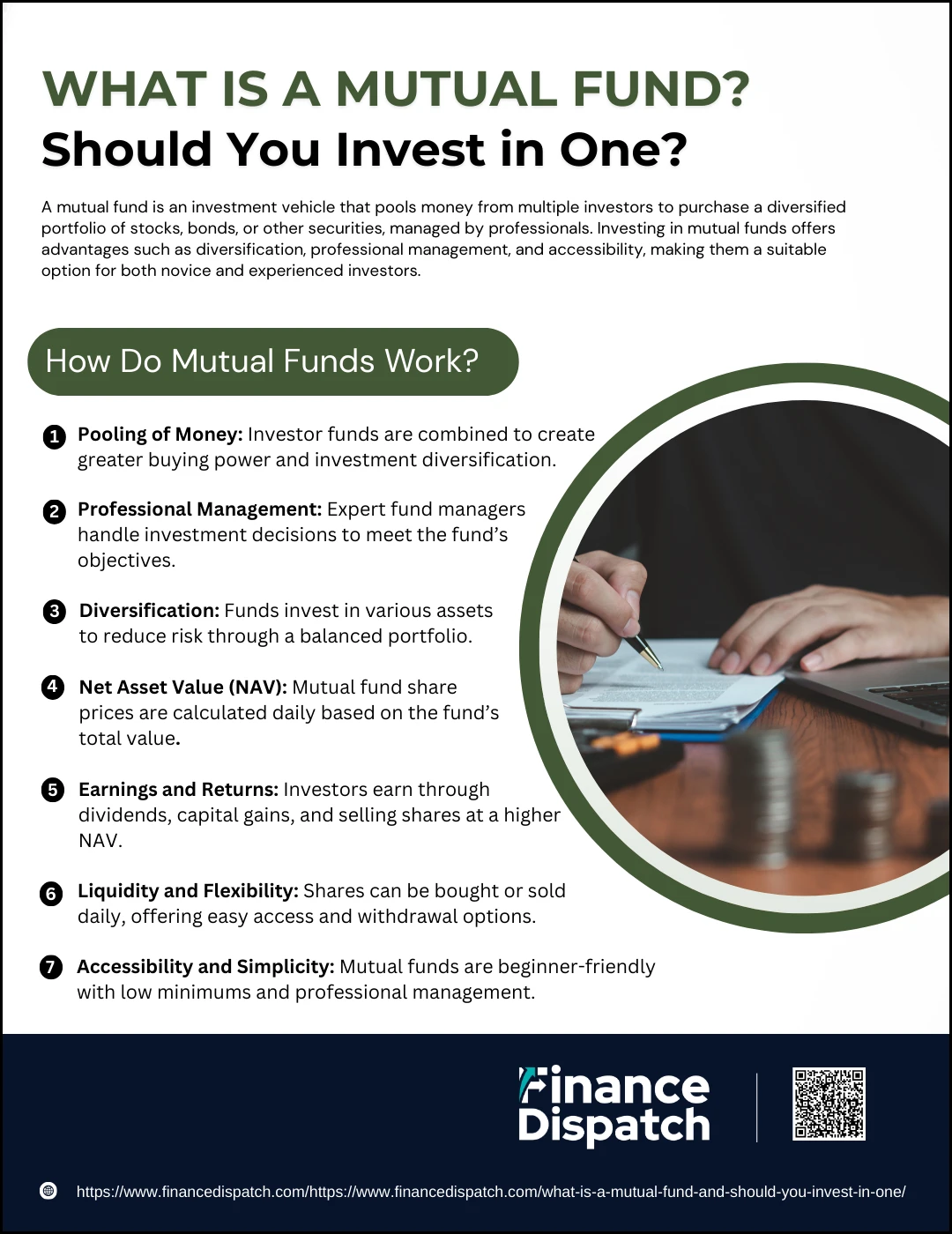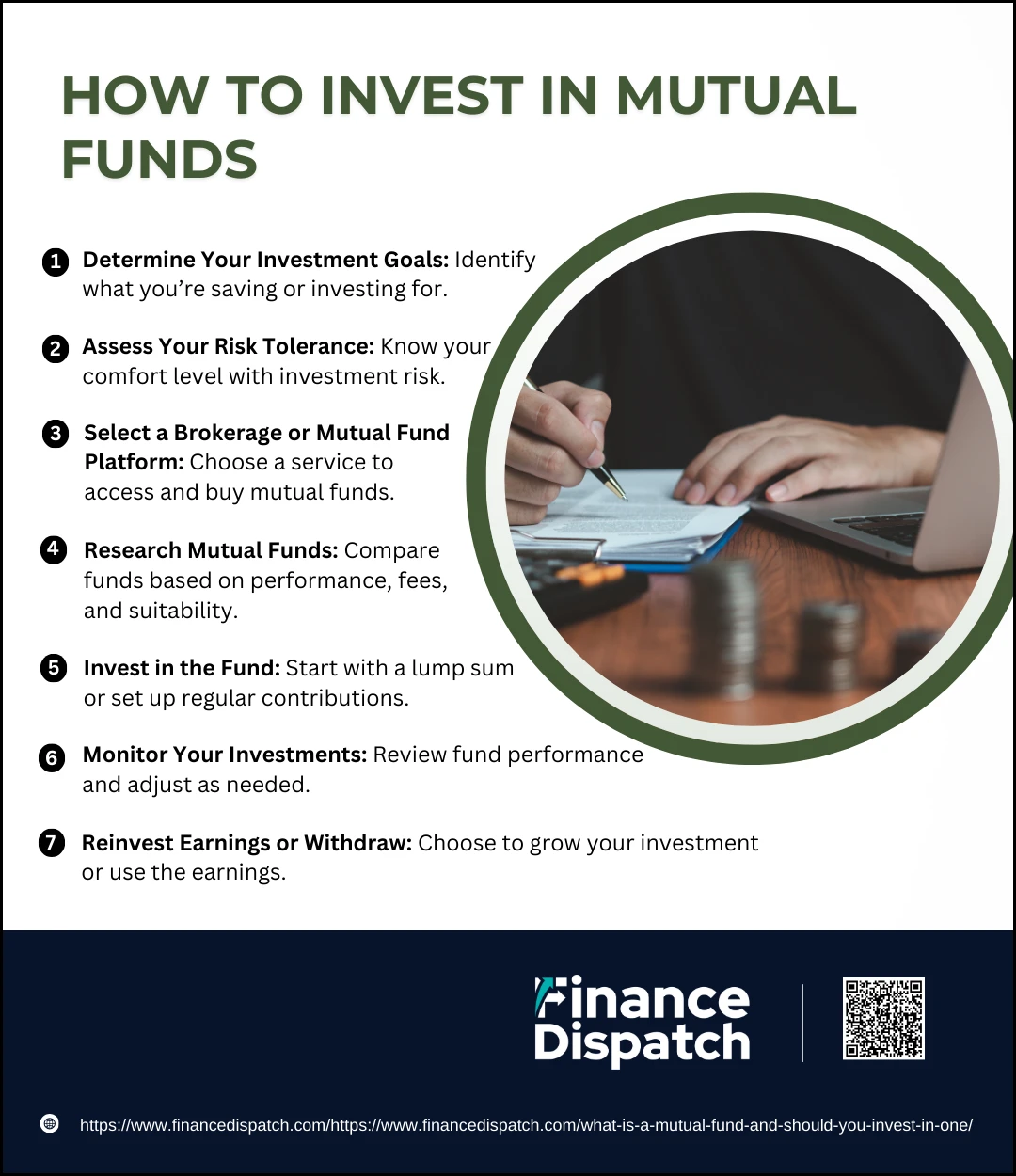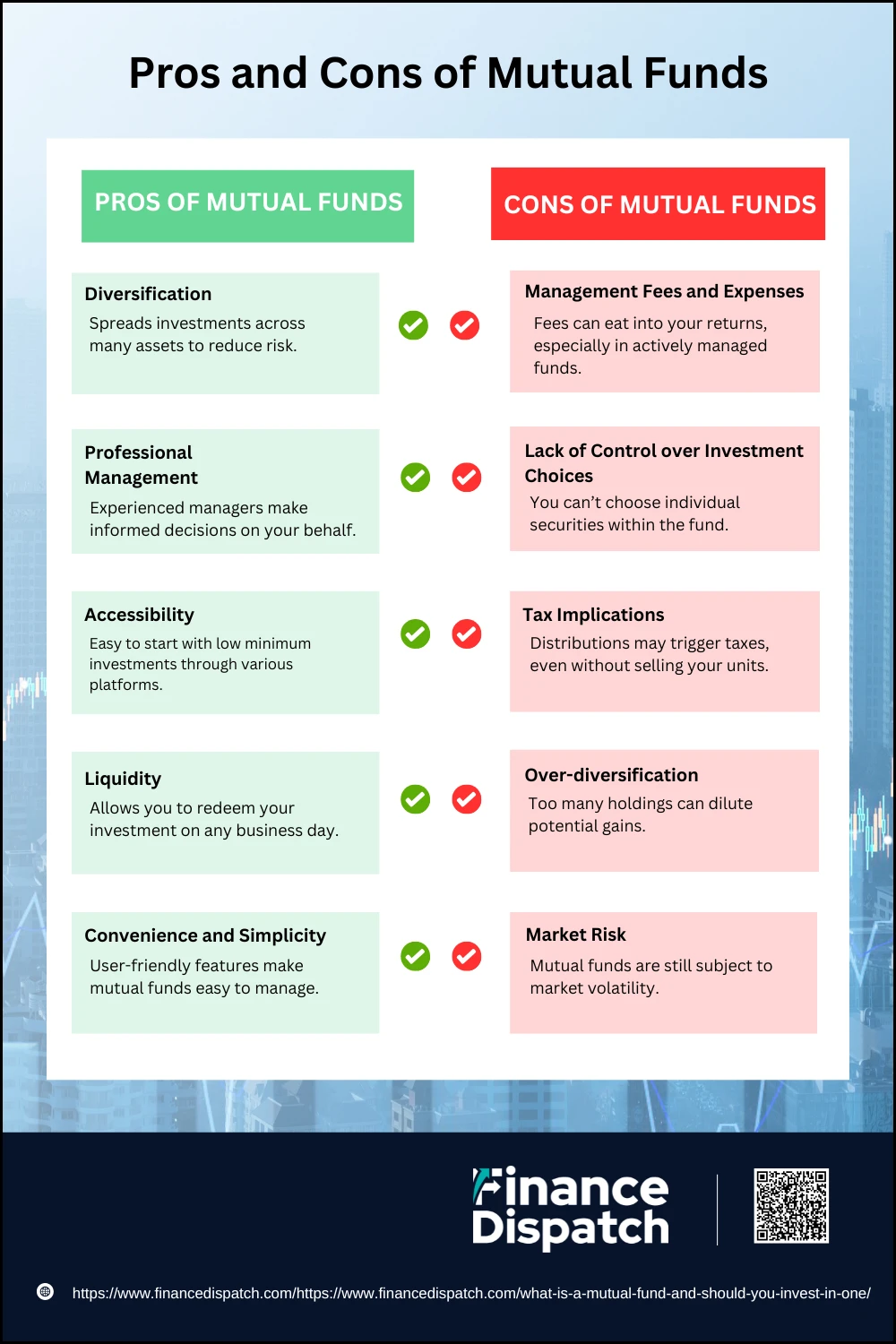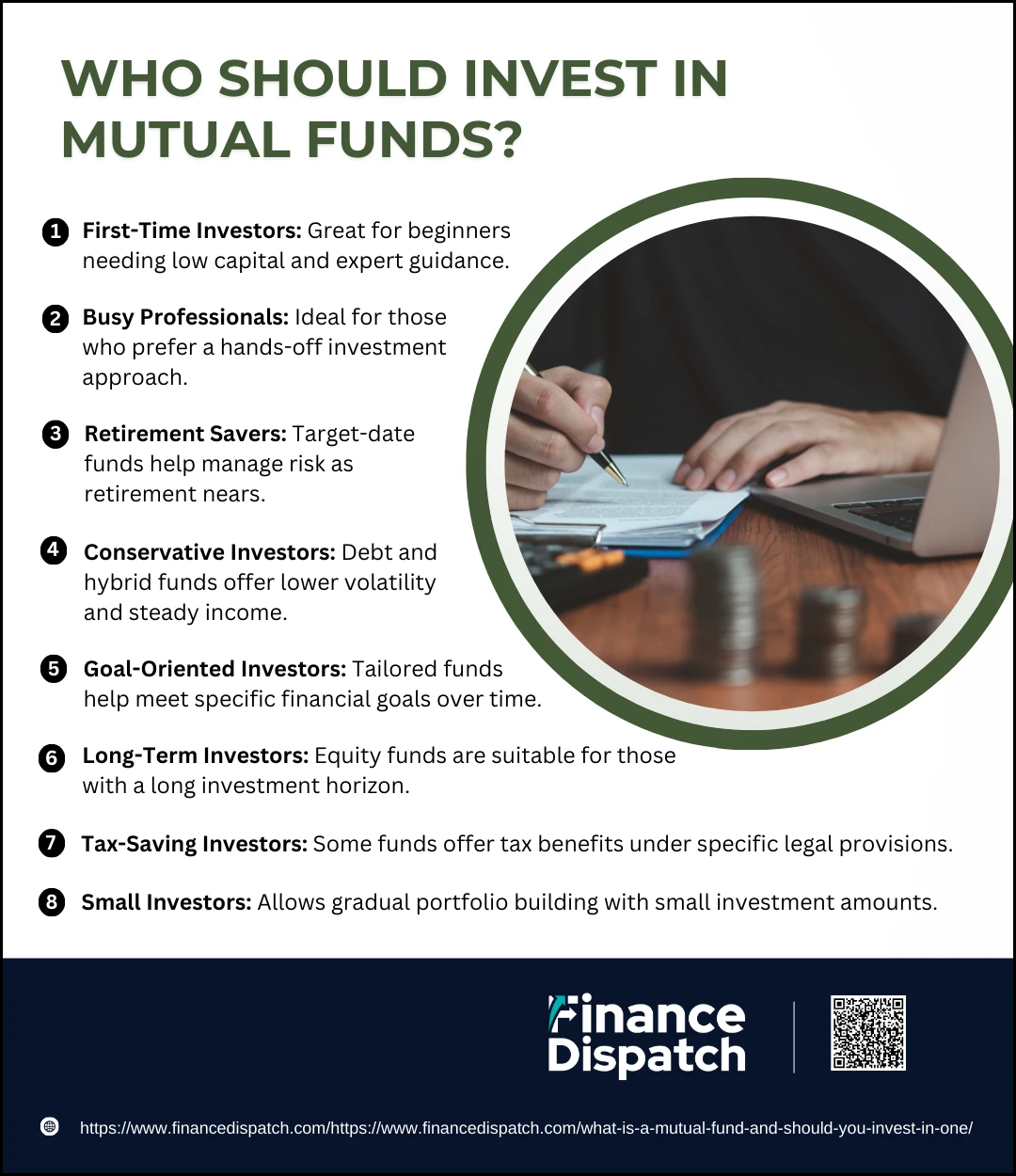If you’ve ever wondered how to grow your money without constantly monitoring the stock market or picking individual stocks, mutual funds might be the answer you’re looking for. A mutual fund is an investment vehicle that pools money from multiple investors to purchase a diversified mix of assets—such as stocks, bonds, or other securities—professionally managed to match specific financial goals. These funds offer a convenient way to access a broad investment portfolio without requiring deep financial expertise or a large starting capital. But with so many options available and varying levels of risk, one important question remains: should you invest in a mutual fund? In this article, we’ll explore what mutual funds are, how they work, their pros and cons, and how to determine if they’re the right fit for your investment strategy.
What is a Mutual Fund?
A mutual fund is a professionally managed investment fund that pools money from multiple investors to buy a diversified portfolio of assets, such as stocks, bonds, or other securities. Instead of picking individual investments yourself, you buy shares of the mutual fund, which gives you partial ownership of all the assets it holds. This approach allows you to benefit from diversification—spreading your money across many investments to reduce risk—and from the expertise of fund managers who make decisions based on the fund’s objectives. Whether you’re aiming for long-term growth, steady income, or a balanced approach, there’s likely a mutual fund designed to match your financial goals.
 How Do Mutual Funds Work?
How Do Mutual Funds Work?
Mutual funds operate by collecting money from many individual investors and using that pooled capital to invest in a diversified portfolio of assets. Rather than buying individual stocks or bonds on your own, you buy shares of the mutual fund. This gives you indirect ownership of a broad range of investments and access to professional money management. The fund is overseen by experienced managers who research the market, select securities, and adjust the portfolio to align with the fund’s objectives—whether that’s growth, income, or a balanced strategy. As the fund’s underlying investments gain or lose value, so does the value of your shares.
Here’s a closer look at how mutual funds work:
1. Pooling of Money
Your money is combined with that of thousands of other investors to create a large fund, which increases buying power and access to a wide range of securities.
2. Professional Management
Experienced fund managers and analysts make investment decisions for the fund, aiming to meet the stated goal—such as capital growth, income generation, or capital preservation.
3. Diversification
Mutual funds invest in a variety of assets—across sectors, industries, and geographies—so poor performance in one investment can be offset by gains in others, reducing overall risk.
4. Net Asset Value (NAV)
Mutual fund shares don’t trade like stocks throughout the day. Instead, they are priced once daily based on the Net Asset Value (NAV), which is the total value of the fund’s assets minus its liabilities, divided by the number of shares.
5. Earnings and Returns
You can earn money in three ways: through dividend or interest income distributed by the fund, capital gains when the fund sells appreciated assets, and by selling your own shares at a higher NAV than what you paid.
6. Liquidity and Flexibility
You can buy or sell mutual fund shares at the end of any trading day, providing a high degree of liquidity. Some funds also allow automatic investment or withdrawal plans.
7. Accessibility and Simplicity
Many mutual funds have low minimum investment requirements, making them ideal for beginners. Plus, all the management and asset allocation work is handled by professionals—saving you time and effort.
Should You Invest in One?
Deciding whether to invest in a mutual fund depends on your financial goals, risk tolerance, and how involved you want to be in managing your investments. Mutual funds are ideal for individuals who prefer a hands-off approach and want professional management to handle asset selection and portfolio balancing. They offer built-in diversification, which helps reduce risk, and are accessible even to those with limited investing experience or smaller capital. If you’re looking for a long-term investment strategy—such as saving for retirement, a child’s education, or building wealth gradually—mutual funds can be a smart choice. However, it’s important to consider the associated fees, performance history, and how well the fund’s strategy aligns with your personal goals before committing.
 Types of Mutual Funds
Types of Mutual Funds
Mutual funds come in many varieties, each structured to serve different financial goals, time horizons, and risk tolerances. Whether you’re saving for retirement, seeking regular income, or simply looking to grow your wealth over time, there’s a mutual fund to match your needs. Understanding the key types of mutual funds will help you choose the right mix for your portfolio and align your investments with your personal strategy.
Here are the main types of mutual funds explained in more detail:
1. Equity (Stock) Funds
These funds primarily invest in shares of publicly traded companies and aim to generate long-term capital growth. They are best suited for investors with a higher risk tolerance. Equity funds can be further classified into large-cap (stable, blue-chip firms), mid-cap (medium-sized growth companies), and small-cap (emerging businesses with high growth potential but more risk). There are also sector-specific, value, growth, and blend funds, each focusing on different investing styles.
2. Debt (Bond) Funds
Debt funds invest in fixed-income securities such as government bonds, corporate bonds, treasury bills, and debentures. They are designed to provide regular income and tend to be less volatile than equity funds. These funds are suitable for conservative investors looking to preserve capital and earn steady returns, especially over the short to medium term.
3. Hybrid Funds
Hybrid or balanced funds invest in both stocks and bonds, combining the growth potential of equities with the stability of debt. Depending on the asset allocation, hybrid funds can be aggressive (more equity), conservative (more debt), or balanced (roughly equal). These funds are ideal for moderate investors who want a mix of safety and returns in one package.
4. Index Funds
Index funds aim to mirror the performance of a specific market index like the S&P 500 or Nifty 50. These are passively managed funds, which means they don’t try to beat the market but instead match its performance. With lower fees and broad market exposure, index funds are a smart option for cost-conscious, long-term investors.
5. Money Market Funds
These funds invest in short-term debt instruments such as Treasury bills, commercial papers, and certificates of deposit. They offer lower risk and high liquidity, making them a good place to park emergency funds or cash needed in the near future. However, their returns are usually modest.
6. Target-Date Funds
Target-date funds are designed for retirement or other long-term goals. They automatically adjust their asset allocation over time—starting with a high exposure to stocks for growth and gradually shifting to bonds for stability as the target date approaches. They offer a “set-it-and-forget-it” strategy for long-term investors.
7. Sector and Thematic Funds
These funds invest in specific sectors (like healthcare, technology, or energy) or themes (like artificial intelligence or clean energy). While they offer high return potential if the sector thrives, they also carry higher risk due to lack of diversification across sectors. These are suitable for investors who have strong convictions about particular industries.
8. International and Global Funds
International funds invest outside your home country, while global funds may include both domestic and foreign investments. These funds allow investors to tap into growth opportunities in global markets and add geographical diversification to their portfolio. However, they come with added risks such as currency fluctuations and geopolitical instability.
9. Fund of Funds (FoFs)
A fund of funds invests in other mutual funds rather than directly in stocks or bonds. This offers a convenient way to access a diversified investment strategy across fund types and asset classes. However, FoFs often have higher fees due to multiple layers of fund management.
10. Solution-Oriented Funds
These mutual funds are created with specific financial goals in mind, such as retirement planning or saving for a child’s education. They typically come with lock-in periods and are structured to encourage long-term, goal-oriented investing. The asset mix adjusts over time to match the investor’s changing needs as the goal approaches.
 How to Invest in Mutual Funds
How to Invest in Mutual Funds
Investing in mutual funds is a straightforward process, even for beginners. These funds provide an easy way to access a diversified portfolio managed by professionals, making them an attractive option for those looking to grow their wealth over time. Whether you’re investing for retirement, saving for a specific goal, or seeking to generate income, mutual funds offer flexibility and convenience. Here’s a step-by-step guide on how to start investing in mutual funds.
1. Determine Your Investment Goals
Before you begin, define your financial objectives. Are you saving for retirement, a child’s education, or simply looking to grow your wealth? Your goals will help determine the type of mutual fund that best suits your needs.
2. Assess Your Risk Tolerance
Understand how much risk you’re willing to take. Mutual funds come in various risk profiles, from low-risk bond funds to high-risk equity funds. Choose funds that align with your comfort level and time horizon.
3. Select a Brokerage or Mutual Fund Platform
Open an account with a brokerage firm, investment platform, or directly with a mutual fund company. Many platforms offer easy access to a wide range of mutual funds, while some specialize in specific funds.
4. Research Mutual Funds
Look into different types of mutual funds that fit your investment goals and risk tolerance. Consider the fund’s performance history, management fees (expense ratio), minimum investment requirement, and asset allocation strategy.
5. Invest in the Fund
Once you’ve selected a mutual fund, decide how much money you want to invest. Many platforms allow you to invest in lump sums or set up automatic monthly contributions.
6. Monitor Your Investments
Regularly check on the performance of your mutual fund. While mutual funds are long-term investments, it’s important to assess how well the fund is meeting your goals and to make adjustments if necessary.
7. Reinvest Earnings or Withdraw
Many mutual funds allow you to reinvest your dividends and capital gains, which can help grow your investment over time. Alternatively, you can choose to withdraw the earnings for income.
How You Earn From Mutual Funds
One of the key benefits of investing in mutual funds is the potential to earn returns in multiple ways. Whether you’re seeking regular income or long-term growth, mutual funds can help grow your wealth through different channels. Understanding how you make money from mutual funds can help you choose the right fund type and set realistic expectations for your investment journey.
Here are the primary ways you earn from mutual funds:
1. Dividend or Interest Income: Some mutual funds generate regular income through dividends (from stocks) or interest payments (from bonds), which are distributed to investors, typically on a quarterly or annual basis.
2. Capital Gains Distributions: When the fund manager sells securities within the fund at a profit, the gains are distributed to investors. These are known as capital gains and can be either short-term or long-term depending on how long the assets were held.
3. Appreciation in Net Asset Value (NAV): As the market value of the fund’s holdings increases, so does the NAV of the mutual fund. If you sell your fund shares at a higher NAV than when you purchased them, you realize a capital gain.
4. Reinvestment of Earnings: Many investors choose to reinvest dividends and capital gains automatically. This increases the number of fund units they own over time, leading to compounded growth.
5. Systematic Withdrawal Plans (SWP): For those seeking a steady income stream, some mutual funds allow systematic withdrawals, where a fixed amount is paid out at regular intervals while the remaining investment continues to grow.
 Pros and Cons of Mutual Funds
Pros and Cons of Mutual Funds
Mutual funds are a popular choice for both new and experienced investors because they offer a balanced mix of simplicity, diversification, and professional management. They can help you gain access to a wide range of assets without needing to select individual stocks or bonds yourself. However, while mutual funds offer many advantages, they also have some limitations that are important to consider before investing. Knowing the full picture can help you make an informed decision that aligns with your financial goals, risk tolerance, and investment style.
Pros of Mutual Funds
1. Diversification
One of the biggest advantages of mutual funds is the ability to diversify your investments. By pooling money from multiple investors, a mutual fund can spread its investments across many different securities, sectors, and asset classes. This diversification helps lower the risk of loss because a downturn in one asset or sector may be offset by gains in another.
2. Professional Management
Mutual funds are managed by experienced fund managers and analysts who make investment decisions on your behalf. They actively research market trends, assess risk, and buy or sell assets to align with the fund’s objectives—something individual investors may not have the time or expertise to do effectively.
3. Accessibility
Mutual funds are easy to purchase through banks, brokers, or online investment platforms. With relatively low minimum investment requirements, they are ideal for beginners or investors with limited capital who still want access to a professionally managed portfolio.
4. Liquidity
Most mutual funds allow you to redeem your units at the current Net Asset Value (NAV) on any business day. This makes mutual funds more liquid than many other investment types like real estate or fixed deposits, allowing you to access your money when you need it.
5. Convenience and Simplicity
Mutual funds are designed to be user-friendly. Features like automatic investment plans (SIPs), reinvestment of earnings, and monthly or quarterly statements make it easy for investors to manage their portfolios with minimal effort or financial knowledge.
Cons of Mutual Funds
1. Management Fees and Expenses
All mutual funds charge an expense ratio to cover management and administrative costs. Actively managed funds tend to have higher fees, which can reduce your overall returns—especially if the fund doesn’t consistently outperform the market.
2. Lack of Control over Investment Choices
When you invest in a mutual fund, you’re entrusting the fund manager to make all the investment decisions. You cannot choose or exclude individual assets from the fund’s portfolio, even if some holdings don’t align with your personal preferences.
3. Tax Implications
Even if you don’t sell your fund units, you may be liable to pay taxes on capital gains and dividends distributed by the fund. This can lead to unexpected tax bills, especially in actively managed funds with high turnover.
4. Over-diversification
While diversification generally reduces risk, excessive diversification can dilute your potential returns. If a fund holds too many securities, the performance of high-growth assets may have minimal impact on the overall fund’s performance.
5 Market Risk
Despite all the benefits, mutual funds are still exposed to market volatility. The value of your investment can fluctuate depending on economic conditions, interest rate changes, geopolitical events, and other factors affecting the financial markets.
Mutual Funds vs. Other Investment Options
When building an investment portfolio, it’s important to compare mutual funds with other popular investment options like stocks, ETFs, and bonds. Each investment vehicle has its own set of characteristics, benefits, and risks. Mutual funds are often praised for their diversification and professional management, but they may not be suitable for every investor or financial goal. Comparing them side by side with other options can help you determine the best fit for your strategy, risk tolerance, and involvement level.
Here’s a table comparing mutual funds with other common investment options:
| Feature | Mutual Funds | Stocks | ETFs (Exchange-Traded Funds) | Bonds |
| Ownership | Shares in a pooled fund of many assets | Direct ownership of a single company | Shares in a pooled fund of assets | Loan to a company or government |
| Management | Actively or passively managed by professionals | Self-managed | Usually passively managed (some active ETFs exist) | Typically self-selected |
| Diversification | High (broad mix of assets) | Low (unless multiple stocks are bought) | High (like mutual funds) | Low to medium |
| Liquidity | Bought/sold at end of trading day (NAV) | Can be traded any time during market hours | Traded throughout the day like stocks | Depends on type; some may have lock-in periods |
| Costs/Fees | Management fees (expense ratio), possible load fees | Brokerage fees, capital gains tax | Lower expense ratios than mutual funds | Lower costs; may have purchase premiums |
| Risk Level | Varies by fund type | High (market-dependent) | Varies by ETF type | Generally lower, but subject to interest rate risk |
| Tax Efficiency | Less tax efficient (capital gains distributions) | Taxable only on realized gains | More tax efficient than mutual funds | Interest is taxable; capital gains taxed if sold early |
| Ease for Beginners | High – simple to start with automatic options | Medium – requires research and active monitoring | High – combines ease and control | Medium – requires understanding of bond ratings |
| Minimum Investment | Often low (e.g., $500 or less) | Cost depends on stock price | Typically price of 1 share (can be low) | Varies based on bond type and issuer |
| Income Potential | Dividends and capital gains | Dividends and price appreciation | Similar to mutual funds | Regular fixed interest payments |
Evaluating a Mutual Fund
Before investing in a mutual fund, it’s essential to evaluate whether the fund aligns with your financial goals, risk tolerance, and investment timeline. Start by reviewing the fund’s objective—whether it aims for growth, income, or capital preservation—and make sure it matches your own purpose. Next, look at the fund’s historical performance over different market cycles, keeping in mind that past performance doesn’t guarantee future results but can offer insight into consistency. Consider the fund’s expense ratio, which indicates how much you’ll pay annually in fees, as even small percentages can eat into long-term returns. Also examine the fund manager’s experience and track record, the types of assets held in the portfolio, and the level of risk involved. Finally, compare the fund with similar funds in its category to see how it stacks up in terms of returns, volatility, and cost. A well-evaluated mutual fund can be a powerful tool in helping you achieve your long-term financial objectives.
 Who Should Invest in Mutual Funds?
Who Should Invest in Mutual Funds?
Mutual funds are designed to cater to a wide range of investors, regardless of their experience level, financial goals, or investment capital. Whether you’re just starting your financial journey or planning for retirement, mutual funds offer flexibility, diversification, and professional management that can suit your needs. However, choosing the right mutual fund also depends on your specific circumstances, such as your risk tolerance, time horizon, and income requirements. Here are the types of individuals who may benefit most from investing in mutual funds:
1. First-Time Investors
Mutual funds are ideal for beginners because they don’t require deep market knowledge. You can start with small amounts and let professional managers handle the investment decisions.
2. Busy Professionals
If you don’t have time to research stocks or actively manage your investments, mutual funds offer a convenient, hands-off approach to building wealth.
3. Retirement Savers
Target-date and balanced mutual funds are great for retirement planning. They automatically adjust their risk exposure as your retirement date approaches.
4. Conservative Investors
Those who prioritize capital preservation and regular income can opt for debt funds or conservative hybrid funds with lower volatility.
5. Goal-Oriented Investors
If you’re saving for a specific goal—like a child’s education, home purchase, or wedding—there are solution-oriented mutual funds tailored to those timelines and objectives.
6. Long-Term Investors
People with long investment horizons (5+ years) can benefit from equity or growth mutual funds, which tend to offer higher returns over time despite short-term fluctuations.
7. Tax-Saving Investors
Mutual funds like Equity-Linked Saving Schemes (ELSS) in some countries provide tax benefits under specific laws, making them attractive for those looking to reduce taxable income.
8. Small Investors
With low minimum investment thresholds, mutual funds are accessible to those with limited capital, enabling them to build a diversified portfolio gradually.
Are Mutual Funds Safe Investments?
Mutual funds are generally considered a relatively safe investment option, especially for those seeking diversification and professional management. However, they are not completely risk-free. The safety of a mutual fund depends on the type of fund you choose and the underlying assets it holds. For example, equity funds carry higher risk due to market volatility, while debt funds and money market funds tend to be more stable but may offer lower returns. Importantly, mutual funds are not insured by the government, meaning there’s no guarantee against losses. That said, by investing in a well-diversified mutual fund aligned with your financial goals and risk tolerance, you can reduce exposure to unnecessary risk and work toward steady, long-term growth. Always remember to review the fund’s strategy, track record, and risk profile before investing to ensure it matches your comfort level.
Can You Withdraw Money From a Mutual Fund Anytime?
Yes, in most cases, you can withdraw money from a mutual fund at any time, but the process and consequences may vary depending on the type of fund. Open-ended mutual funds, which are the most common, allow you to redeem your units on any business day at the current Net Asset Value (NAV). This provides a high level of liquidity, making it easy to access your money when needed. However, some funds may charge exit loads or redemption fees if you withdraw within a certain period, especially in the case of equity or tax-saving funds. Additionally, early withdrawals may trigger capital gains taxes depending on how long you’ve held the investment. Therefore, while mutual funds offer flexibility, it’s important to understand the specific terms and tax implications before redeeming your investment.
Real-Life Examples of Mutual Fund
Mutual funds are used by people from all walks of life to achieve different financial goals—whether it’s saving for the future, generating income, or managing risk. Here are a few short examples showing how different individuals use mutual funds effectively:
1. Young Professional: Invests in equity mutual funds through SIPs for long-term wealth building.
2. Parent: Uses hybrid and ELSS funds to save for a child’s education while enjoying tax benefits.
3. Retiree: Chooses debt mutual funds with monthly payouts for stable retirement income.
4. First-Time Investor: Starts with an index fund for broad market exposure and low fees.
5. Entrepreneur: Parks surplus cash in liquid funds for short-term returns and easy access.
Conclusion
Mutual funds offer a versatile and accessible way to invest, making them a valuable option for both beginners and experienced investors. With benefits like diversification, professional management, and flexibility, they can help you reach a variety of financial goals—from building long-term wealth to generating regular income. However, it’s important to choose the right type of fund based on your risk tolerance, time horizon, and investment objectives. By understanding how mutual funds work, evaluating them carefully, and aligning them with your personal goals, you can make informed decisions that support your financial future.



